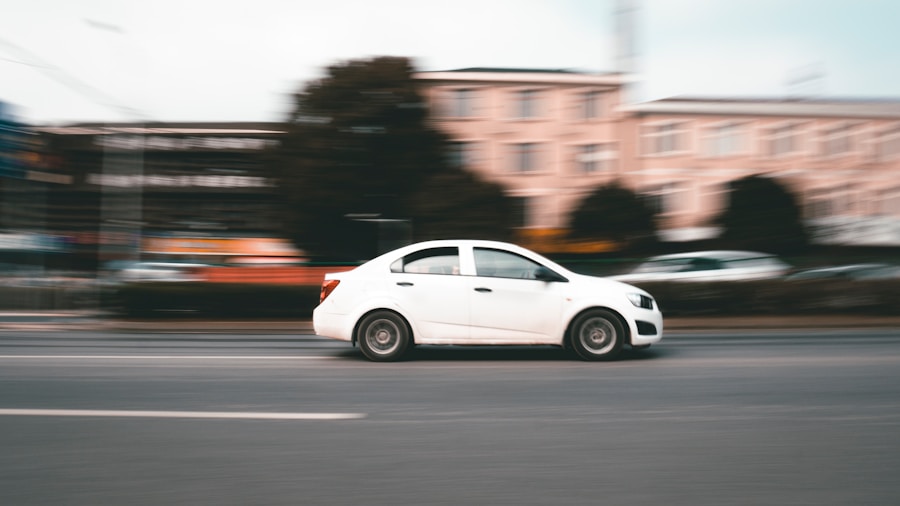The distinction between urban and rural areas is a significant factor in determining car insurance premiums. Urban areas, characterized by high population density, often experience a greater number of vehicles on the road, leading to increased traffic congestion and a higher likelihood of accidents. Insurance companies assess risk based on these factors, and as a result, urban dwellers typically face higher premiums.
For instance, cities like New York and Los Angeles have notoriously high insurance rates due to their dense populations and the associated risks of accidents, theft, and vandalism. The sheer volume of cars increases the probability of collisions, which insurers must account for when calculating premiums. Conversely, rural areas tend to have lower population densities, resulting in fewer vehicles on the road and, consequently, a reduced risk of accidents.
In these regions, the likelihood of encountering traffic congestion is minimal, and the open roads often lead to fewer claims related to collisions. For example, a driver in a small town in Nebraska may pay significantly less for car insurance than someone living in downtown Chicago. However, it is essential to note that while rural areas may have lower premiums due to fewer accidents, they can also face unique risks such as wildlife collisions or longer emergency response times, which insurers may factor into their pricing models.
Key Takeaways
- Urban areas generally have higher population density, leading to increased risk and higher car insurance premiums.
- Insurance rates can vary significantly across different states due to regional differences in factors such as traffic congestion, crime rates, and weather-related risks.
- Higher crime rates in certain areas can result in increased car insurance prices due to the higher likelihood of theft or vandalism.
- Location in areas prone to natural disasters or extreme weather can lead to higher insurance premiums to account for the increased risk of damage to vehicles.
- Traffic congestion and accident rates in urban areas can lead to higher insurance costs, as the likelihood of accidents and vehicle damage is higher.
Insurance rates can vary dramatically from one state to another, influenced by a multitude of factors including state regulations, local economies, and demographic trends. For instance, states like Michigan have historically had some of the highest car insurance premiums in the nation due to their no-fault insurance laws and high medical costs associated with accidents. In contrast, states such as Vermont and Maine often report lower average premiums, attributed to their lower population density and fewer claims overall.
This disparity highlights how regional differences can significantly impact the cost of car insurance. Moreover, the economic landscape of a state plays a crucial role in determining insurance rates. States with robust economies and higher average incomes may see higher premiums as more drivers can afford comprehensive coverage.
Conversely, states with struggling economies may have lower premiums but could also face challenges such as higher uninsured motorist rates. Additionally, local weather patterns can influence rates; for example, states prone to severe weather events like hurricanes or tornadoes may see increased premiums due to the heightened risk of vehicle damage. Understanding these regional differences is essential for consumers seeking to navigate the complexities of car insurance pricing.
The Impact of Crime Rates on Car Insurance Prices
Crime rates are a critical factor that insurers consider when determining car insurance premiums. Areas with high rates of vehicle theft or vandalism typically see elevated insurance costs as insurers must account for the increased risk of loss. For example, cities with high crime rates such as Detroit or Baltimore often have significantly higher premiums compared to more secure suburban or rural areas.
Insurers analyze crime statistics meticulously; if a neighborhood is known for frequent car break-ins or thefts, they will adjust their rates accordingly to mitigate potential losses. In addition to theft and vandalism, other crime-related factors can influence insurance costs. For instance, areas with high rates of violent crime may also experience higher premiums due to the perceived risk associated with driving in those neighborhoods.
Insurers may also consider the overall safety of an area when setting rates; neighborhoods with community watch programs or active policing may enjoy lower premiums compared to those with little law enforcement presence. Consequently, consumers living in high-crime areas must be aware that their location can significantly impact their car insurance costs.
Weather and Natural Disasters: How Location Can Increase Risk and Premiums

The geographical location of a driver plays a pivotal role in determining car insurance premiums, particularly concerning weather patterns and the risk of natural disasters. Regions prone to severe weather events—such as hurricanes in Florida or blizzards in the Northeast—often face higher insurance costs due to the increased likelihood of vehicle damage from these occurrences. For instance, during hurricane season, insurers brace for a surge in claims related to flooding and wind damage, prompting them to raise premiums for residents in affected areas.
Moreover, the frequency and severity of natural disasters can lead insurers to reassess their risk models continually. Areas that experience regular flooding may see not only higher premiums but also stricter coverage limitations or exclusions related to flood damage. Similarly, regions susceptible to wildfires may face increased rates as insurers account for the potential loss of vehicles due to fire damage.
As climate change continues to exacerbate weather-related risks, consumers in vulnerable areas may find themselves facing rising premiums as insurers adapt their pricing strategies to reflect these evolving threats.
Traffic Congestion and Accident Rates: How Location Impacts Insurance Costs
Traffic congestion is another critical factor influencing car insurance premiums. Urban areas with heavy traffic often experience higher accident rates due to the sheer volume of vehicles on the road. Insurers analyze accident statistics meticulously; cities like Los Angeles or San Francisco are notorious for their traffic jams and high collision rates, leading to elevated insurance costs for residents.
The correlation between congestion and accidents is well-documented; as traffic increases, so does the likelihood of fender benders and more serious collisions.
However, it is essential to recognize that while rural drivers may face fewer collisions overall, they might encounter different risks such as longer response times for emergency services or accidents involving wildlife.
Insurers take these factors into account when determining rates; thus, while urban drivers may pay more due to congestion-related risks, rural drivers must also be aware of their unique challenges that could impact their premiums.
The Influence of Local Laws and Regulations on Car Insurance Prices
Local laws and regulations significantly shape car insurance pricing across different regions. Each state has its own set of laws governing minimum coverage requirements, liability limits, and no-fault insurance systems. For example, states like California require drivers to carry liability coverage with specific minimum limits, while others may have more lenient requirements.
These legal frameworks directly influence how much drivers pay for insurance; states with stringent coverage mandates often see higher premiums as insurers must account for the increased risk associated with higher coverage limits. Additionally, local regulations regarding uninsured motorists can also impact insurance costs. States with high rates of uninsured drivers may prompt insurers to raise premiums for those who are insured to offset potential losses from accidents involving uninsured parties.
Furthermore, some states offer discounts for safe driving records or participation in defensive driving courses; these incentives can lead to lower premiums for conscientious drivers.
Proximity to High-Risk Areas: How Living Near Hazardous Locations Can Raise Premiums

Living near high-risk areas can significantly influence car insurance premiums. Insurers often assess the proximity of a driver’s residence to hazardous locations such as industrial zones, high-crime neighborhoods, or areas prone to natural disasters when calculating rates. For instance, a driver residing near an industrial area with a history of chemical spills or accidents may face higher premiums due to the increased risk associated with potential environmental hazards.
Moreover, proximity to high-crime areas can also elevate insurance costs. Even if a driver lives in a relatively safe neighborhood, being just a few blocks away from a high-crime zone can lead insurers to classify them as higher risk. This classification results from statistical analyses indicating that crime can spill over into adjacent neighborhoods, increasing the likelihood of theft or vandalism for vehicles parked nearby.
Consequently, consumers should be aware that their location relative to hazardous areas can have a direct impact on their car insurance costs.
The Role of Zip Codes in Determining Car Insurance Rates
Zip codes serve as a critical tool for insurers when determining car insurance rates. Each zip code is associated with specific demographic data, crime statistics, traffic patterns, and even weather-related risks that help insurers assess the likelihood of claims in that area. For example, urban zip codes often correlate with higher accident rates and theft incidents compared to rural zip codes; thus, residents in densely populated areas typically face higher premiums.
Additionally, zip codes can reveal trends related to socioeconomic status that further influence insurance pricing. Areas with higher income levels may see lower uninsured motorist rates and fewer claims overall, leading to more favorable premium rates for residents. Conversely, zip codes associated with lower income levels might experience higher claims frequency due to economic factors that increase the likelihood of accidents or thefts.
Insurers utilize this data not only to set initial rates but also to adjust them over time based on changing demographics and local conditions. Understanding how zip codes impact car insurance pricing can empower consumers to make informed decisions about their coverage options based on their specific location.
If you’re interested in learning more about how location can impact your insurance costs, you may want to check out this article on auto insurance. Understanding how your location can affect your car insurance rates is crucial in finding the best coverage for your needs. By exploring the factors that influence insurance costs in different areas, you can make informed decisions about your coverage options.
FAQs
What factors about location impact car insurance costs?
Location can impact car insurance costs due to factors such as crime rates, population density, traffic congestion, and the likelihood of natural disasters.
How does crime rate affect car insurance costs?
Areas with higher crime rates tend to have more incidents of theft, vandalism, and break-ins, which can lead to higher car insurance premiums.
Why does population density impact car insurance costs?
Areas with higher population density often have more traffic congestion and a greater likelihood of accidents, leading to higher car insurance premiums.
How does traffic congestion affect car insurance costs?
Areas with heavy traffic congestion are more prone to accidents, which can result in higher car insurance premiums for drivers in those areas.
Why does the likelihood of natural disasters impact car insurance costs?
Areas prone to natural disasters such as hurricanes, tornadoes, or earthquakes may have higher car insurance premiums due to the increased risk of damage to vehicles.
Are there specific locations that tend to have higher car insurance costs?
Urban areas, areas with high crime rates, and regions prone to natural disasters often have higher car insurance costs compared to rural or suburban areas with lower crime rates and less traffic congestion.


